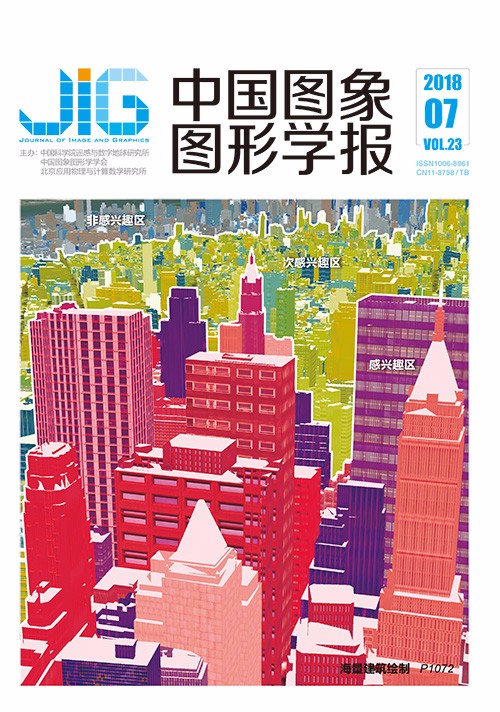
加权核范数降噪算法在扩散加权图像中的应用
摘 要
目的 扩散加权成像技术是一种能够检测活体组织内水分子扩散运动的无创方法,其对数据的准确度要求较高且对噪声较为敏感。扩散加权图像的自相似性程度高,纹理细节较多且纹理和结构具有重复出现的特性。而获取图像的过程中受到不可避免的噪声干扰会破坏图像的数据准确度,因此对扩散加权图像进行降噪是十分必要的。方法 根据扩散加权图像的特点,提出将加权核范数降噪算法应用于扩散加权图像的降噪。加权核范数降噪算法由于能够利用图像的自相似性,通过对图像中的相似块进行处理从而实现对图像的降噪,该算法能够保存图像中大量的纹理细节信息。结果 通过模拟数据实验和真实数据实验,将加权核范数降噪算法与传统的扩散加权图像降噪算法如各向异性算法进行比较,结果表明,加权核范数降噪算法相较于其他算法得到的峰值信噪比至少高出20 dB,结构相似性值也至少高出其他算法0.20.5,再将降噪后的图像进行神经纤维跟踪处理,得到的神经纤维平均长度较其他算法至少要长0.20.8且纤维更为平滑。结论 加权核范数降噪算法不仅能够更好地减少扩散加权图像中的噪声,同时也能够最大限度地保存扩散加权图像的纹理细节,降噪效果理想,提高了数据的准确度及有效性。
关键词
Application of weighted nuclear norm denoising algorithm in diffusion-weighted image
Yi Sanli, Li Sijie, He Jianfeng, Zhang Guifang(Institute of Information Engineering and Automation, Kunming University of Science and Technology, Kunming 650500, China) Abstract
Objective Diffusion-weighted imaging is a noninvasive method of detecting the diffusion of water molecules in living tissues and requires highly accurate data. Diffusion-weighted images have a high degree of self-similarity and rich feature details. The acquisition of diffusion-weighted images is often corrupted by noise and artifacts. Diffusion tensor images are calculated by the diffusion-weighted images. Meanwhile, diffusion tensor imaging is widely used in nerve fiber tracking in human brains. Noise affects the data accuracy of the diffusion tensor image and can cause erroneous tracking of fibers. Noise also affects subsequent processes. Therefore, the noise in the diffusion-weighted image should be reduced. Denoising is not only an important pre-processing step for many vision applications but also an ideal test bed for evaluating statistical image modeling methods.Method According to the characteristics of diffusion-weighted images, the weighted nuclear norm denoising algorithm is proposed for diffusion-weighted image denoising; this algorithm adopts the image nonlocal self-similarity. First, the diffusion-weighted image is divided into many target blocks, and the nonlocal similar blocks can be obtained from the entire image by block matching. The nonlocal similar blocks of the image can be obtained by a sufficiently large local window instead of the entire image. Second, the obtained nonlocal similar blocks are stacked into a similar block matrix, and then the similar block matrix is decomposed by a singular value decomposition. Large singular values are more important than small ones because they represent the energy of the major components of the image. Therefore, different singular values are assigned various weights. Third, the singular values obtained are shrunk by the soft-thresholding operator to acquire the denoised nonlocal similar blocks. The larger the singular values, the less they should be shrunk. By aggregating the denoised blocks, the target block can be estimated. Finally, by applying the above procedures to each target block and aggregating all blocks together, the denoised image can be reconstructed.Result The weighted nuclear norm denoising algorithm is compared with traditional diffusion-weighted image denoising algorithms, such as anisotropic algorithm and texture detection algorithm, by simulation and real data experiments. Simulation results show that the peak signal-to-noise ratio of the weighted nuclear norm denoising algorithm is at least 20 dB higher than those of the other traditional algorithms, and the structural similarity's value is 0.20.5 higher than those of the other algorithms. In the real data experiment, the neural fibers obtained by the tracking of the diffusion-weighted images denoised by different algorithms are compared. The use of the number of fibers or the length of the longest fiber to judge the effect of noise reduction fails to represent the noise reduction effect satisfactorily, according to our findings. Therefore, the average length of fibers is proposed to express the denoising effect. The longer the average length, the better the denoising effect and that the smoother the fibers. Results show that the average length and the texture of the nerve fibers obtained by denoising using the weighted nuclear denoising algorithm is sufficiently long and smooth, respectively.Conclusion An analysis of the experiment shows that the weighted nuclear norm denoising algorithm maximizes the self-similarity of the diffusion-weighted images and achieves image denoising through the processing of similar blocks. The weighted nuclear norm denoising algorithm can not only reduce the noise in the diffusion-weighted image and lead to visible peak signal-to-noise ratio improvements over state-of-the-art methods, such as texture detection, but also preserve the image's local structures better and generate less visual artifacts. The proposed algorithm can obtain improved results and DTI data accuracy and validity, which are helpful in the subsequent processing of images.
Keywords
diffusion weighted imaging weighted nuclear norm denoising algorithm image denoising peak signal-to-noise ratio nerve fiber tracking
|



 中国图象图形学报 │ 京ICP备05080539号-4 │ 本系统由
中国图象图形学报 │ 京ICP备05080539号-4 │ 本系统由